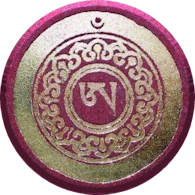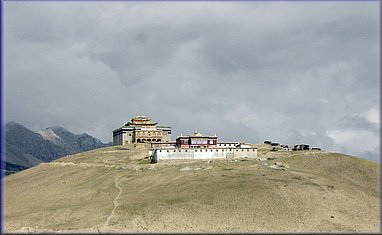
A Brief History of Dolma Lhakang
The reason for the renown of Dolma Lhakang is as follows. There were three famous Dolma (Arya Tara) monasteries set in the geographical profile of the dharma land of Tibet. In the Lhasa area of central Tibet there was the Nyetang Dolma Lhakang, the seat of the Great Dharma Lord Palden Atisha. The main dharma artefact there was Atisha's own White Tara of the Wish-Fulfilling Wheel, an image that had been heard to speak. Around this were twenty-one statues of Tara, in the Jo style, that Karmapa Rangjung Dorje had had made from gold and copper. That monastery became famous as a Tara temple through the exceptional quality of those images. The second was in the Kham region of Tibet, in Langtang: the Den Dolma Lhakang which also had a Tara image which had spoken. Concerning the third, the mahasiddha Master Padmasambhava (in union aspect) subdued places through his own miraculous presence by putting or manifesting Tara images which protect beings from the eight great fears. There were various ones here and there in Tibet, appearing at different times
 |
in its history but the ones at Tsawa Gang were the best known as they have been able to protect against powerful natural catastrophes and they had the power to bestow the blessing of the four accomplishments. In Tsawa Gang there were twenty-one naturally-arisen Tara images. Left: present-day, reconstructed Dolma Lhakang |
Tsawa Gang Dolma Lhakang gained a unique reputation through its connection with this and other nearby sacred places of pilgrimage. In the upper part of Tsawa Gang, in the north of Gepchu Tsangwa, is a place of great blessing, a mountan called Ku-la, which is seen as the buddha palace of Chakrasamvara. It has the shape of a majestic lion. To the south is the Tsaritra sacred place. Concerning this, during the hundred years of strife, some powerful asuras, along with their consorts, almost took over the sacred charnel grounds of this world. In response, the Supreme Sage and Teacher emanated inconceivable forms of Chakrasamvara. In order to clearly distinguish each of the different teachings associated with these forms, in which sutra and tantra are united, very many major and ancillary sites sacred to each specific one were established. If one takes our land of Tibet as an example, then within the area bounded by the white snowlands of Rongtsen and Nepal to the west and by Tsaritsa-Bhutan in the south, one finds athousand minor sacred sites, it is said.
This southern mountain has famously been recognised by Karmi Khenpo Rinchen Darjay as the secondary site of Tsandho Haru. Outwardly, on a physical level, Ku-la mountain is a sacred protective place of a fusion of the three families. On an inner level, it is a sacred place of speech for the twenty-one Taras. On a secret level, it is a mind seat for Chakrasamvaracitta. The sacred speech location of Tara just mentioned was predicted in a terma text revealed by Taksham Nuden Dorje: the Tsawa meteoric rock of speech, due to the lung of Urgyen Dorje, is a dwelling-place of the four accomplishments. Very vivid shapes symbolising body, speech and mind are on its summit. There is the Sky Treasury practice cave of the yab-yum guru, a sacred place of the great terma of Samten Lingpa. Related to it are many terma treasures concerning dharma, wealth, substances and medicine entrusted to the goddess Bardongma, who is guardian of the 'Space Section' of the Dzogchen teachings. There are also the sadhana cycle of Guru Zilnön, in union form, the treasure casket containing the pratice manual, along with activities, of Damchen and Tenma, the complete gtor cha of dakini Yeshe Tsogyal and a union form of Dam-Ten made of alabaster. This is a brief description of the outer, inner and secret places, famous for actually lending itself to wonderful great terma treasures such as these.
